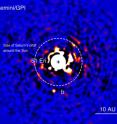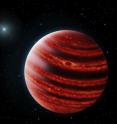Astronomers discover 'young Jupiter' exoplanet
Related images
(click to enlarge)
A team of astronomers that includes UA researchers Travis Barman and Katie Morzinski has discovered a Jupiter-like planet within a young star system. The new planet, called 51 Eridani b, is the first exoplanet discovered by the Gemini Planet Imager, a new instrument operated by an international collaboration headed by Bruce Macintosh, a professor of physics at Stanford University and member of the Kavli Institute for Particle Astrophysics and Cosmology. A million times fainter than its star, 51 Eridani, 51 Eri b shows the strongest methane signature ever detected in the atmosphere of an alien planet, which should yield additional clues about how the planet formed.
"51 Eri b is the first young planet that probably looks like Jupiter did billions of years ago, making it currently our most important corner-piece of the planet formation jigsaw puzzle," said Travis Barman, a UA associate professor of planetary sciences and a leading theorist on the GPI team. "The current properties of 51 Eri b may hold a record of its formation history, and future studies of its atmosphere will hopefully unlock new information about planet formation in general."
The team's results are scheduled for publication in the Science online-first edition on August 13, 2015.
A clear line of sight
The Gemini Planet Imager (GPI) was designed specifically for discovering and analyzing faint, young planets orbiting bright stars. In contrast, NASA's Kepler mission indirectly discovers planets by the loss of starlight when a planet blocks a star.
Macintosh said, "To detect planets, Kepler sees their shadow; GPI sees their glow. What GPI does is called direct imaging. The astronomers use adaptive optics to sharpen the image of a star, and then block out the starlight. Any remaining incoming light is then analyzed, the brightest spots indicating a possible planet.
After GPI was installed on the 8-meter Gemini South Telescope in Chile, the team set out to look for planets orbiting young stars. They've looked at almost a hundred stars so far.
"This is exactly the kind of planet we envisioned discovering when we designed GPI", says James Graham, professor at UC Berkeley and Project Scientist for GPI.
As far as the cosmic clock is concerned, the star 51 Eridani is young - only 20 million years old - which is exactly what made the direct detection of its planet possible. When planets coalesce, material falling into the planet releases energy and heats it up. During the first hundred million years they radiate that energy away, mostly as infrared light.
Once the astronomers zeroed in on the star, they blocked its light and spotted 51 Eri b orbiting a little farther away from its parent star than Saturn does from our Sun. The light from the planet is very faint - more than three million times fainter than its star - but GPI can see it clearly. Observations revealed the planet is roughly twice the mass of Jupiter. Other directly imaged planets are five times the mass of Jupiter or more.
When GPI takes images, it does so across many wavelengths of light simultaneously, allowing astronomers to detect the presence of different gasses in a planet's atmosphere. The first images taken with GPI immediately revealed obvious signs of abundant methane gas in the atmosphere of 51 Eri b -- the strongest methane signal measured among the exoplanets discovered so far.
Methane is an important molecule in Jupiter's atmosphere and it is natural to expect it in gas giants orbiting other stars. The few planets imaged so far, however, are a bit peculiar and appear to contain only small amounts of methane. 51 Eri b is the first that truly looks methane rich and "Jupiter-like". Of course, it's not exactly like Jupiter. The planet is so young it's still shining with energy released from its formation - a temperature of 800 degrees Fahrenheit, hot enough to melt lead.
"Many of the exoplanets astronomers have imaged before have atmospheres that look like very cool stars" said Macintosh, who led the construction of GPI and now leads the planet-hunting survey. "This one looks like a planet."
Barman said, "The presence of methane is an important indicator of low temperature, and low temperature is one indicator that 51 Eri b is close to the mass of Jupiter."
"We have been searching for evidence of methane since the first exoplanet was discovered as it implies conditions similar to what we see in the atmospheres of our own giant planets in the Solar System. To have found such an extraordinary example of a methane-rich atmosphere so early in our survey with GPI is really encouraging."
The key to the solar system?
One of the best ways to learn how our Solar System formed and has evolved is by studying younger star systems in the early stages of development. In addition to expanding the universe of known planets, GPI will provide key clues as to how other solar systems form.
"The exoplanets that are easiest to detect are so close to their stars that they are scorched. But the exoplanets we can detect with GPI are cooler worlds, allowing us to study the pristine atmospheres of still-cooling planets like 51 Eri b," said Morzinski, an assistant astronomer at the UA's Steward Observatory. "Direct imaging gives us access to planets that are most similar to the giant planets in our own Solar System."
Astronomers believe that the gas giants in our Solar System formed by building up a large core over a few million years and then pulling in a huge amount of hydrogen and other gasses to form an atmosphere.
But the Jupiter-like exoplanets that have so far been discovered are much hotter than some models have predicted. This suggests that they could have formed much faster, as material collapses quickly to make a very hot planet. This is an important difference. The core-buildup process can also form rocky planets like the Earth; a fast and hot collapse might only make giant gassy planets. 51 Eridani b is young enough that it 'remembers' its formation.
There are hundreds of planets a little bigger than Earth out there, Macintosh said, but there is so far no way to know if they are really "super-Earths" or just micro-sized gas and ice planets like Neptune or something different all together. Using GPI to study more young solar systems such as 51 Eridani, he said, will help astronomers understand the formation of our neighbor planets, and how common that planet-forming mechanism is throughout the universe.
Source: University of Arizona
Articles on the same topic
- Young, Jupiter-like planet discoveredThu, 13 Aug 2015, 21:13:43 UTC
- Astronomers discover 'young Jupiter' exoplanetThu, 13 Aug 2015, 21:13:31 UTC
- Lawrence Livermore scientists discover new young planetThu, 13 Aug 2015, 21:01:54 UTC
- Astronomers discover 'young Jupiter' exoplanetThu, 13 Aug 2015, 20:13:54 UTC
- Jupiter-like planet discovered outside our solar systemThu, 13 Aug 2015, 20:13:41 UTC
- Astronomers discover 'young Jupiter' exoplanetThu, 13 Aug 2015, 18:57:41 UTC
- Methane, water enshroud nearby Jupiter-like exoplanetThu, 13 Aug 2015, 18:57:10 UTC
- Astronomers discover 'young Jupiter' exoplanetThu, 13 Aug 2015, 18:56:55 UTC
- Gemini-discovered world is most like JupiterThu, 13 Aug 2015, 18:56:44 UTC
Other sources
- 'Young Jupiter' exoplanet discovery: Q&A with astronomer Eric Nielsenfrom PhysorgMon, 17 Aug 2015, 14:30:45 UTC
- Found! 'Young Jupiter,' the Smallest Exoplanet Directly Seen by Telescopefrom Live ScienceFri, 14 Aug 2015, 22:30:20 UTC
- Distant "young Jupiter" could shed light on solar systemfrom CBSNews - ScienceFri, 14 Aug 2015, 16:00:24 UTC
- Young 'alien Jupiter' discoveredfrom BBC News: Science & NatureFri, 14 Aug 2015, 11:10:16 UTC
- Young, Jupiter-like planet discoveredfrom Science BlogThu, 13 Aug 2015, 23:10:09 UTC
- Astronomers photograph a baby Jupiter in another solar systemfrom Reuters:ScienceThu, 13 Aug 2015, 23:10:06 UTC
- Astronomers Discover 'Young Jupiter' Exoplanetfrom Newswise - ScinewsThu, 13 Aug 2015, 21:00:07 UTC
- Baby Jupiter discovered by new planet-hunting camerafrom CBC: Technology & ScienceThu, 13 Aug 2015, 19:20:08 UTC
- Astronomers discover 'young Jupiter' exoplanetfrom Science DailyThu, 13 Aug 2015, 18:50:36 UTC
- Found! 'Young Jupiter,' the Smallest Exoplanet Directly Seen by Telescopefrom Space.comThu, 13 Aug 2015, 18:50:29 UTC
- Methane, water enshroud nearby Jupiter-like exoplanetfrom PhysorgThu, 13 Aug 2015, 18:21:13 UTC
- Astronomers Glimpse a Young Jupiter, 51 Eridani bfrom Scientific AmericanThu, 13 Aug 2015, 18:20:53 UTC
- 'Young Jupiter' Discovered 100 Light-Years Awayfrom MSNBC: ScienceThu, 13 Aug 2015, 18:20:51 UTC
- 'Young Jupiter' 51 Eridani b: Why Directly Imaging an Exoplanet Is Big (Kavli Q+A)from Space.comThu, 13 Aug 2015, 18:20:27 UTC
- Exoplanet 51 Eridani b: A Red-Hot Young Jupiter Around Distant Star (Infographic)from Space.comThu, 13 Aug 2015, 18:20:26 UTC
- Astronomers Discover "Young Jupiter" Exoplanetfrom Newswise - ScinewsThu, 13 Aug 2015, 18:20:09 UTC
- Astronomers Discover 'Young Jupiter' Exoplanetfrom Newswise - ScinewsThu, 13 Aug 2015, 18:20:05 UTC

